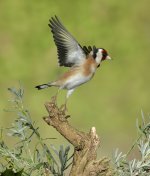If there are is anyone still following the saga of how I developed my system for using flash to photograph small garden birds, this post should at last give the secret away.
Warning. It gets a bit complicated.
I had struggled with using the flash on reduced power, as in spite of it working on dull days, I could not easily get rid of all the ambient light on sunny days, leading to ghosting.
Further research brought me to a possible answer - HSS. This stands for High Speed Synchronisation and is a way to use flash with high shutter speeds.
Normally, a flash fires a burst of light for about 1/300th of a second while the shutter is fully open. The problem is, at any shutter speed faster than 1/250th of a second, the shutter is never completely open. The first shutter curtain starts to travel across the sensor, allowing light to enter and before it reaches the other side the second curtain follows, cutting off the light again. The faster the shutter speed, the sooner the second one starts and the narrower the gap between the two curtains. The actual speed of the curtains is always the same.
The secret of HSS is that instead of a single burst of light, the flash unit fires a continuous series of pulses at very high speed, from the moment the first curtain starts to open, until after the second one finishes. This means that as the gap between the curtains travels across the frame, there is always light from the flash falling on it - just as it does in normal daylight. In fact, this is the secret of HSS - it acts just like daylight.
Wow! You can use flash just like daylight. Any shutter speed up to the maximum that your camera will allow. My Canon camera will let me shoot at up to 1/8000th of a second, easily enough to freeze the motion of garden birds.
And there is more.
Any daylight is simply added to the overall exposure. One sunny days, I simply need less flash.
Sounds too good to be true? Well, yes, there are problems.
The first, obvious problem is that your camera and flash units need to be able to support HSS. Not all do. luckily, my Canon camera does. When it came to flash units, I couldn’t really afford three Canon Speedlites, so looked around for a cheaper alternative. What I settled on was probably the best photography purchase I have ever made - I bought three Godox TT600 units and a Godox flash trigger, all for the cost of one Canon flash!
That’s it. That is my secret. Three flash units on HSS - two to light up the bird and one to light the background, all controlled wirelessly by a Godox trigger.
In the future I will go over the actual set up with the perch and background and the other “small” problems with HSS flash.
Does it work?
This photo was taken with my set up:-

Warning. It gets a bit complicated.
I had struggled with using the flash on reduced power, as in spite of it working on dull days, I could not easily get rid of all the ambient light on sunny days, leading to ghosting.
Further research brought me to a possible answer - HSS. This stands for High Speed Synchronisation and is a way to use flash with high shutter speeds.
Normally, a flash fires a burst of light for about 1/300th of a second while the shutter is fully open. The problem is, at any shutter speed faster than 1/250th of a second, the shutter is never completely open. The first shutter curtain starts to travel across the sensor, allowing light to enter and before it reaches the other side the second curtain follows, cutting off the light again. The faster the shutter speed, the sooner the second one starts and the narrower the gap between the two curtains. The actual speed of the curtains is always the same.
The secret of HSS is that instead of a single burst of light, the flash unit fires a continuous series of pulses at very high speed, from the moment the first curtain starts to open, until after the second one finishes. This means that as the gap between the curtains travels across the frame, there is always light from the flash falling on it - just as it does in normal daylight. In fact, this is the secret of HSS - it acts just like daylight.
Wow! You can use flash just like daylight. Any shutter speed up to the maximum that your camera will allow. My Canon camera will let me shoot at up to 1/8000th of a second, easily enough to freeze the motion of garden birds.
And there is more.
Any daylight is simply added to the overall exposure. One sunny days, I simply need less flash.
Sounds too good to be true? Well, yes, there are problems.
The first, obvious problem is that your camera and flash units need to be able to support HSS. Not all do. luckily, my Canon camera does. When it came to flash units, I couldn’t really afford three Canon Speedlites, so looked around for a cheaper alternative. What I settled on was probably the best photography purchase I have ever made - I bought three Godox TT600 units and a Godox flash trigger, all for the cost of one Canon flash!
That’s it. That is my secret. Three flash units on HSS - two to light up the bird and one to light the background, all controlled wirelessly by a Godox trigger.
In the future I will go over the actual set up with the perch and background and the other “small” problems with HSS flash.
Does it work?
This photo was taken with my set up:-




